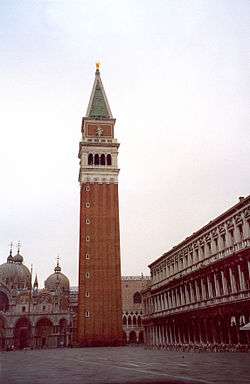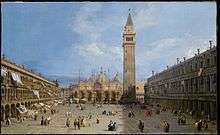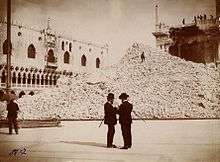St Mark's Campanile

St Mark's Campanile (Italian: Campanile di San Marco; Venetian: Canpanièl de San Marco) is the bell tower of St Mark's Basilica in Venice, Italy, located in the Piazza San Marco. It is one of the most recognizable symbols of the city.
The tower is 98.6 metres (323 ft) tall, and stands alone in a corner of St Mark's Square, near the front of the basilica. It has a simple form, the bulk of which is a fluted brick square shaft, 12 metres (39 ft) wide on each side and 50 metres (160 ft) tall, above which is a loggia surrounding the belfry, housing five bells. The belfry is topped by a cube, alternate faces of which show the Lion of St. Mark and the female representation of Venice (la Giustizia: Justice). The tower is capped by a pyramidal spire, at the top of which sits a golden weathervane in the form of the archangel Gabriel. The campanile reached its present form in 1514. The current tower was reconstructed in its present form in 1912 after the collapse of 1902.
History


The initial 9th-century construction, initiated during the reign of Pietro Tribuno (887-912) and built on Roman foundations,[1] was used as a watch tower or lighthouse for the dock, which then occupied a substantial part of the area which is now the Piazzetta. Construction was finished in the twelfth century, during the reign of Domenico Morosini. Adjoining the base of the campanile is the loggetta built by Sansovino, completed in 1549 and rebuilt in 1912 after it had been destroyed by the fall of the campanile. One of the models for the tower was the St. Mercuriale's Campanile, in Forlì.
Repeated restoration
The campanile suffered damage by lightning on many occasions. It was severely damaged in 1388, set on fire and destroyed in 1417 and seriously damaged by a fire in 1489 that destroyed the wooden spire.[2]
The campanile assumed its definitive shape in the sixteenth century thanks to the restorations made to repair further damage caused by the earthquake of March 1511. These works, initiated by the architect Giorgio Spavento, then executed under the direction of Bartolomeo Bon of Bergamo, added the belfry, realized in marble; the attic, on which was put the sculpture of the lion of Saint Mark and Venice; and the spire, in gold leaf. The work was completed on 6 July 1513, with the placement of the gilded wooden statue of the Archangel Gabriel in the course of a ceremony recorded by Marin Sanudo.
In the following centuries numerous other interventions were made to repair the damage from fires caused by lightning. It was damaged in 1548 and 1565.[2] In 1653, Baldassarre Longhena took up the restorations. The campanile was damaged by lightning again in 1658.[2] More work was done after a fire caused by a lightning strike on 13 April 1745, which caused some of the masonry to crack, and killed several people as a result of falling stonework. The campanile was damaged by lightning again in 1761 and 1762. Finally, in 1776, it was equipped with a lightning rod.[2]
In 1820, the statue of the angel was replaced with a new one by Luigi Zandomeneghi.
Collapse and rebuilding

_-_BEIC_6346672.jpg)
In July 1902, the north wall of the tower began to show signs of a dangerous crack that in the following days continued to grow. Finally, on Monday, 14 July, around 9:45 am, the campanile collapsed completely, also demolishing the loggetta. Remarkably, no one was killed, except for the caretaker's cat.[3] Because of the campanile's position, the resulting damage was relatively limited. Apart from the loggetta, only a corner of the Biblioteca Marciana was destroyed. The pietra del bando, a large porphyry column from which laws used to be read, protected the basilica itself.

The same evening, the communal council approved over 500,000 Lire for the reconstruction of the campanile. It was decided to rebuild the tower exactly as it was, with some internal reinforcement to prevent future collapse, plus installing an elevator. Royal Privy Councillor and scaffolding specialist Georg Leib of Munich was the first to donate his scaffolding to rebuild St. Mark's Campanile, on 22 July 1902. [4] Work lasted until 6 March 1912. The work was carried out by the construction firm of G.A.Porcheddu. The new campanile was inaugurated on 25 April 1912, on the occasion of Saint Mark's feast day, exactly 1000 years after the foundations of the original building had allegedly been laid.[5]
Replicas
The original Campanile inspired the designs of other towers worldwide, especially in the areas belonging to the former Republic of Venice. Almost identical, albeit smaller, replicas of the campanile exist in the Slovenian town of Piran and in the Croatian town of Rovinj; both were built in the early 17th century. Other, later replicas include the clock tower at King Street Station in Seattle;[6] North Toronto Station; Brisbane City Hall, Australia; the Rathaus (Town Hall) in Kiel Germany; the Daniels & Fisher Tower in Denver; the Campanile in Port Elizabeth- South Africa; Sather Tower, nicknamed the Campanile, on the campus of the University of California, Berkeley;[7] 14 Wall Street; and the right-hand bell-tower of St. John Gualbert in Johnstown, Pennsylvania.
The Metropolitan Life Insurance Company Tower, a landmark skyscraper located at One Madison Avenue in the borough of Manhattan in New York City, US, was designed by the architectural firm of Napoleon LeBrun & Sons, who based the external form and shape of the skyscraper on this Campanile.
Replicas of the current tower sit on the complex of The Venetian, the Venice-themed resort on the Las Vegas Strip, its sister resort The Venetian Macao, in the Italy Pavilion at Epcot, a theme park at Walt Disney World in Lake Buena Vista, Florida, and in the nearly empty New South China Mall in Dongguan, China.
There is a mill chimney in Darwen, Lancashire which is modelled on the Campanile in St. Mark's Square, Venice, called India Mill. Another one is in the Venice Grand Canal in Taugig City.
The Venetian Towers in Barcelona, Spain, are modelled on the Campanile.
The Italianate-style tower at Jones Beach State Park, Long Island, New York, is modelled on the Campanile.[8]
The Sretenskaya church in Bogucharovo, Tula region, Russia is modelled on the Campanile.[9]
Bells
Each of the five bells of the campanile had a special purpose. The Renghiera (or the Maleficio) announced executions; the Mezza Terza proclaimed a session of the Senate; the Nona sounded midday; the Trottiera called the members of the Maggior Consiglio to council meetings and the Marangona, the biggest, rang to mark the beginning and ending of working day. They are tuned in the scale of A.
Current restoration work
The Campanile is currently undergoing a major set of building works that are forecast to last a few years. Like many buildings in Venice, it is built on soft ground, supported by wooden piles. Due to years of winter flooding (Acqua Alta), the subsoil has become saturated and the campanile has begun to subside and lean. Evidence of this can be seen in the increasing number of cracks in the masonry. In order to stop the damage, a ring of titanium is being built underneath the foundations of the campanile. The titanium ring will protect the campanile from the shifting soil and ensure that the tower subsides equally and does not lean.
It is still possible to climb the Campanile during these works.
Gallery
%2C_Venice%2C_Campanile_from_Piazza_Feb_1998.jpg) The west face of the Campanile seen from the Piazza (during Carnival in Feb.1998)
The west face of the Campanile seen from the Piazza (during Carnival in Feb.1998)%2C_12.jpg) View, vertical section and ground-plans (1831) before the crash – the reconstruction is nearly identical
View, vertical section and ground-plans (1831) before the crash – the reconstruction is nearly identical- Top of the tower
- Detail of the tower
- Detail of the tower
 The Belfry
The Belfry
In popular culture
Galileo Galilei famously demonstrated his telescope to the Doge of Venice Antonio Priuli on 21 August 1609 from the Campanile.[10] There is a plaque commemorating this event at the viewing area of the tower.
The 1902 collapse of the Campanile plays a role in American novelist Thomas Pynchon's 2006 novel Against the Day, in which an aeronautical battle between ambiguously fictitious airships results in the spectacular fall of the structure.
The Campanile, along with much of the city of Venice, appears in the video game Assassin's Creed II, in which the playable character, Ezio Auditore da Firenze, can scale the tower in the years 1480–1499 to view the city from on high.
The Japanese manga Gunslinger Girl by Yu Aida is set in Italy. Volume 11 of the series revolves mainly around terrorists taking over the Campanile and the subsequent battle with the authorities.
Venice-themed Japanese anime Aria the OVA: Arietta depicts a walk to the top of St. Mark's Campanile, via the pedestrian ramp path, which is no longer accessible to the general public.
References
- ↑ Lorenzetti p.144
- 1 2 3 4 Block 2004
- ↑ Produced, written and directed by David DeVries (2003-11-04). "Inviting Disaster 4". Modern Marvels. The History Channel.
- ↑ "Stadtchronik 1902: Bemerkenswertes, Kurioses und Alltägliches" (in German), muenchen.de.
- ↑ Iain Fenlon, Piazza San Marco, page 147, Profile Books, 2009
- ↑ Margaret A. Corley (March 1973). "National Register of Historic Places Inventory -- Nomination Form" (PDF). National Park Service, Department of Interior. Archived from the original (PDF) on 10 September 2008. Retrieved 27 August 2007.
- ↑ Finacom, Steven. "Berkeley Landmarks: Sather Tower (Campanile)". Retrieved 5 March 2008.
- ↑ Bleyer, Bill (5 October 2010). "Copper roof installed on Jones Beach water tower (partly subscriber access)". Newsday. Retrieved 20 October 2016.
- ↑ arch_heritage (2008-01-31). "АТАКА КЛОНОВ: колокольня в усадьбе Богучарово". АРХИТЕКТУРНОЕ НАСЛЕДИЕ. Retrieved 2018-07-14.
- ↑ David Whitehouse, "Renaissance Genius: Galileo Galilei & His Legacy to Modern Science", Sterling Publishing, 2009, p. 77
Bibliography
- Lorenzetti, Giulio: Venice and its Lagoon (1926. 2nd edn 1956) translated by John Guthrie (Lint, Trieste. 1975)
- Block, Seymour Stanton (2004). Benjamin Franklin, Genius of Kites, Flights and Voting Rights. Jefferson, North Carolina: McFarland & Company, Inc. ISBN 9780786419425.
External links
| Wikimedia Commons has media related to Campanile of St. Mark's Basilica. |
- Satellite image from Google Maps
- Photo spread of Venice, special events and isles of its region (texts and Venice's history in German)
